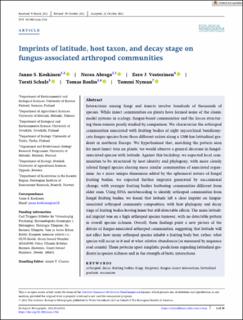| dc.contributor.author | Koskinen, Janne S. | |
| dc.contributor.author | Abrego, Nerea | |
| dc.contributor.author | Vesterinen, Eero J. | |
| dc.contributor.author | Schulz, Torsti | |
| dc.contributor.author | Roslin, Tomas | |
| dc.contributor.author | Nyman, Tommi | |
| dc.date.accessioned | 2022-10-07T12:28:11Z | |
| dc.date.available | 2022-10-07T12:28:11Z | |
| dc.date.created | 2022-05-10T12:29:43Z | |
| dc.date.issued | 2022-03-09 | |
| dc.identifier.citation | Ecological Monographs. 2022, 92 (3), . | en_US |
| dc.identifier.issn | 0012-9615 | |
| dc.identifier.uri | https://hdl.handle.net/11250/3024531 | |
| dc.description.abstract | Interactions among fungi and insects involve hundreds of thousands of species. While insect communities on plants have formed some of the classic model systems in ecology, fungus-based communities and the forces structuring them remain poorly studied by comparison. We characterize the arthropod communities associated with fruiting bodies of eight mycorrhizal basidiomycete fungus species from three different orders along a 1200-km latitudinal gradient in northern Europe. We hypothesized that, matching the pattern seen for most insect taxa on plants, we would observe a general decrease in fungal-associated species with latitude. Against this backdrop, we expected local communities to be structured by host identity and phylogeny, with more closely related fungal species sharing more similar communities of associated organisms. As a more unique dimension added by the ephemeral nature of fungal fruiting bodies, we expected further imprints generated by successional change, with younger fruiting bodies harboring communities different from older ones. Using DNA metabarcoding to identify arthropod communities from fungal fruiting bodies, we found that latitude left a clear imprint on fungus-associated arthropod community composition, with host phylogeny and decay stage of fruiting bodies leaving lesser but still-detectable effects. The main latitudinal imprint was on a high arthropod species turnover, with no detectable pattern in overall species richness. Overall, these findings paint a new picture of the drivers of fungus-associated arthropod communities, suggesting that latitude will not affect how many arthropod species inhabit a fruiting body but, rather, what species will occur in it and at what relative abundances (as measured by sequence read counts). These patterns upset simplistic predictions regarding latitudinal gradients in species richness and in the strength of biotic interactions. | en_US |
| dc.language.iso | eng | en_US |
| dc.publisher | Wiley Periodicals LLC on behalf of The Ecological Society of America | en_US |
| dc.rights | Navngivelse-Ikkekommersiell 4.0 Internasjonal | * |
| dc.rights.uri | http://creativecommons.org/licenses/by-nc/4.0/deed.no | * |
| dc.title | Imprints of latitude, host taxon, and decay stage on fungus-associated arthropod communities | en_US |
| dc.title.alternative | Imprints of latitude, host taxon, and decay stage on fungus-associated arthropod communities | en_US |
| dc.type | Peer reviewed | en_US |
| dc.type | Journal article | en_US |
| dc.description.version | publishedVersion | en_US |
| dc.rights.holder | © 2022 The Authors | en_US |
| dc.source.pagenumber | 19 | en_US |
| dc.source.volume | 92 | en_US |
| dc.source.journal | Ecological Monographs | en_US |
| dc.source.issue | 3 | en_US |
| dc.identifier.doi | 10.1002/ecm.1516 | |
| dc.identifier.cristin | 2023063 | |
| dc.source.articlenumber | e1516 | en_US |
| cristin.ispublished | true | |
| cristin.fulltext | original | |
| cristin.qualitycode | 2 | |

